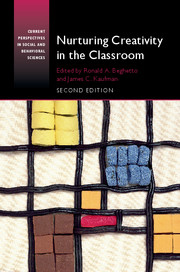Book contents
- Frontmatter
- Dedication
- Contents
- Preface
- Acknowledgments
- PART I VOICES FROM THE FIELD
- PART II VOICES FROM THE RESEARCH
- 5 Developing Creativity Across All Areas of the Curriculum
- 6 Accountability, the Common Core, and Creativity
- 7 Ever-Broadening Conceptions of Creativity in the Classroom
- 8 Creativity in Mathematics Teaching: A Chinese Perspective (An Update)
- 9 Roads Not Taken, New Roads to Take: Looking for Creativity in the Classroom
- 10 The Five Core Attitudes and Seven I's of the Creative Process
- 11 Creativity Embedded into K–12 Teacher Preparation and Beyond
- 12 Attitude Change as the Precursor to Creativity Enhancement
- 13 Nurturing Creativity in the Engineering Classroom
- 14 Intrinsic Motivation and Creativity in the Classroom: Have We Come Full Circle?
- 15 Learning for Creativity
- 16 Creativity and Prosocial Values: Nurturing Cooperation within the Classroom
- 17 How Social-Emotional Imagination Facilitates Deep Learning and Creativity in the Classroom
- 18 Four Faces of Creativity at School
- 19 Teaching for Creativity
- 20 A Coda for Creativity in the Classroom: Take-Home Points and Final Insights
- Index
- References
10 - The Five Core Attitudes and Seven I's of the Creative Process
from PART II - VOICES FROM THE RESEARCH
Published online by Cambridge University Press: 24 November 2016
- Frontmatter
- Dedication
- Contents
- Preface
- Acknowledgments
- PART I VOICES FROM THE FIELD
- PART II VOICES FROM THE RESEARCH
- 5 Developing Creativity Across All Areas of the Curriculum
- 6 Accountability, the Common Core, and Creativity
- 7 Ever-Broadening Conceptions of Creativity in the Classroom
- 8 Creativity in Mathematics Teaching: A Chinese Perspective (An Update)
- 9 Roads Not Taken, New Roads to Take: Looking for Creativity in the Classroom
- 10 The Five Core Attitudes and Seven I's of the Creative Process
- 11 Creativity Embedded into K–12 Teacher Preparation and Beyond
- 12 Attitude Change as the Precursor to Creativity Enhancement
- 13 Nurturing Creativity in the Engineering Classroom
- 14 Intrinsic Motivation and Creativity in the Classroom: Have We Come Full Circle?
- 15 Learning for Creativity
- 16 Creativity and Prosocial Values: Nurturing Cooperation within the Classroom
- 17 How Social-Emotional Imagination Facilitates Deep Learning and Creativity in the Classroom
- 18 Four Faces of Creativity at School
- 19 Teaching for Creativity
- 20 A Coda for Creativity in the Classroom: Take-Home Points and Final Insights
- Index
- References
Summary
When I began working in the field of the education of the gifted and talented, as a county coordinator in Ohio, in 1977, I looked at the categories of giftedness as described in the Marland Report of 1972. These were superior cognitive ability, specific academic ability, creativity, visual and performing arts ability, and psychomotor ability. With regard to the inclusion of creativity as a type of giftedness, I asked myself, “Aren't smart people creative? Aren't people good at academic subjects creative? Aren't visual and performing artists creative? Aren't athletes creative? Why is there a separate category for creativity?” Over the next 13 years I was a county coordinator in two states, and the principal of a school for gifted children. I am now a college professor who runs a graduate program for certification for teachers of the gifted and talented. I am unusual, I suspect, because in my inner life, my real life, I am and have been an artist – a published novelist and a poet – and I see the world not only through the eyes of a researcher in education and psychology but also through an artist's eyes. I have also been what is called a teaching artist (Oreck & Piirto, 2014), as I also worked for four years as a Poet in the Schools in the National Endowment for the Arts “Artist in the Schools” program during the late 1970s and early 1980s.
I got myself trained in many of the current (and still ongoing – not much has changed in the creativity training arena since the 1970s) creativity training programs – Creative Problem-Solving, Future Problem-Solving, and Odyssey of the Mind. I began to think about my own creative process. I learned firsthand from California's Mary Meeker about the Structure of the Intellect (Meeker, 1977; Piirto & Keller-Mathers, 2014), and became one of her first advanced trainers, going around the country giving workshops on Guilford's theory of intellect, as well as on divergent production–fluency, flexibility, elaboration, synthesis, and the like (Guilford, 1950, 1967). Then I would go home and write my literary works, send them out for possible publication, receiving many rejections and enough acceptances to keep me going.
- Type
- Chapter
- Information
- Nurturing Creativity in the Classroom , pp. 131 - 161Publisher: Cambridge University PressPrint publication year: 2016
References
- 1
- Cited by

